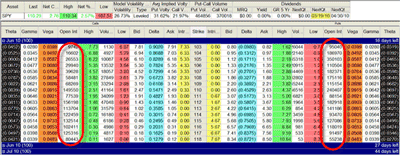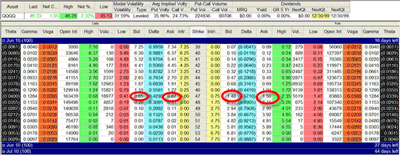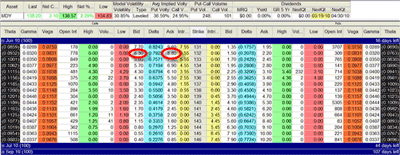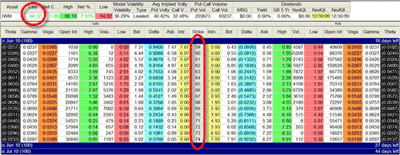Often, students share with me their open option positions, asking me for my opinion of their selections. I have noticed that there is a pattern in the type of mistakes that the novice option traders frequently make. They can be grouped into three areas. They are: (1) Low open interest, (2) Unwinnable bid and ask spreads, and (3) Wide spread between the offered strike prices.
Let me take a closer look at each one of these in greater detail. Open interest of the individual options is very essential, for it represents liquidity. An option trader could get into a situation where there is virtually no one willing to be on the opposite side of his or her trade. Paying close attention to liquidity before even entering could be salvation from disaster. In order to illustrate my point, I will use two visual aids. The option chain in Figure 1 has very few option trades placed, and hence, the liquidity is low. One could get in, but might not be able to get out, assuming that one is long options. This shows quite the opposite picture from Figure 2, which shows an option chain of a stock that has ample liquidity on both calls and puts.
On the figure above, we are looking at IJR, or iShares S&P Small Cap 600. Notice how low open interest is on both the calls and puts. They are circled with red ovals. With the exception of the triple digits on the call side for the June 61 call (928 outstanding contracts), the June 62 call (111 contracts) and the June 66 calls (211 open interest contracts), all other open interest numbers are only double digits, single ones, or even zeros. This is not good.
By contrast, Figure 2 is showing high open interest. The underlying asset is SPY, or SPDR S&P 500. Notice that the smallest open interest is in the four digits, namely, the June 103 call, which has 9,742 contracts. By the way, SPY is one of the most liquid ETFs.
Secondly, let us address the bid and ask spread. If we were trading an actual underlying, we would expect the spread, or difference between the two, to be tight. When it comes to option trading, the bid and ask spread varies depending on traders’ interest in the underlying issue. If more traders are trading, the tighter the bid and ask spread will be. Observe that on Figure 3 below, the PowerShares QQQQ's spread for the June 47 call is in penny wide increments. Specifically, the bid is at 0.65 and the ask is at 0.67. Meanwhile, the June 47 put bid is at 1.48 and the ask at 1.50.
Article Continues on Page 2
|pagebreak|By contrast, Figure 4 shows the very opposite; MDY is the ticker, or S&P Midcap 400, and the June 132 call has the bid at 6.30, while the ask is at 8.80, which is 2.50 points wide.
Lastly, let me scrutinize the importance of having the option list every single strike price handle, versus having them only in five-point increments. Again, I will utilize a visual to bring my point home.
Figure 5 above shows a product that is trading in the range of $68 per share, and the strike prices listed are five points apart. The ticker is UTX, for Untied Technologies Corporations. UTX is one of the Dow components, as well as the S&P 500 and S&P 100. To contrast UTX, I have selected IWM, or iShares Russell 2000 Index, which is trading very close to the price range of UTX.
On Figure 6, IWM is in about the same price range, yet the strike prices aren't in five-point increments. Simply ask yourself, as a trader, which of these two products is more desirable to trade with options: UTX (figure 5) or IWM (figure 6)? Of course, the one with more choices for strike prices is the answer.
When selecting an optionable issue to trade, choose the best possible choice that there is in all three aspects mentioned above. In other words, just because a stock is an optionable issue does not mean that it should be traded using options directionally. If the bid and ask spread is too wide, and there is not enough open interest, there is also a high chance that there will not be a single strike price listing of the options. In such case, simply pass. Skip trading that specific product. The criteria that I am looking for when trading options are: High option liquidity (open interest), tight bid and ask spread, and single-point strike increments.
As my predecessor would say: Know thy options before you trade them.
By Josip Causic, trader and instructor, OnlineTradingAcademy.com
















